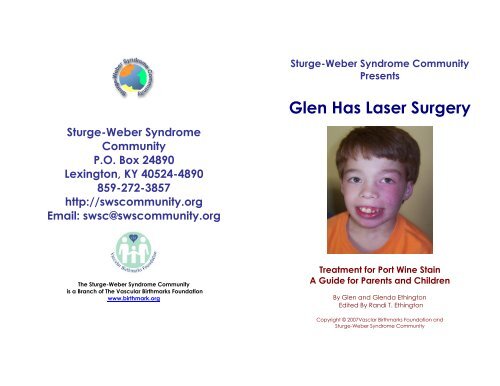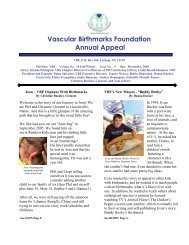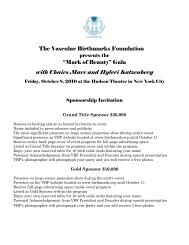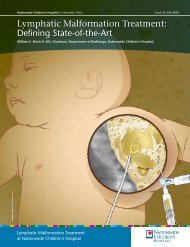Glen Has Laser Surgery, Treatment for - Sturge-Weber Syndrome ...
Glen Has Laser Surgery, Treatment for - Sturge-Weber Syndrome ...
Glen Has Laser Surgery, Treatment for - Sturge-Weber Syndrome ...
You also want an ePaper? Increase the reach of your titles
YUMPU automatically turns print PDFs into web optimized ePapers that Google loves.
<strong>Sturge</strong>-<strong>Weber</strong> <strong>Syndrome</strong> Community<br />
Presents<br />
<strong>Glen</strong> <strong>Has</strong> <strong>Laser</strong> <strong>Surgery</strong><br />
<strong>Sturge</strong>-<strong>Weber</strong> <strong>Syndrome</strong><br />
Community<br />
P.O. Box 24890<br />
Lexington, KY 40524-4890<br />
859-272-3857<br />
http://swscommunity.org<br />
Email: swsc@swscommunity.org<br />
The <strong>Sturge</strong>-<strong>Weber</strong> <strong>Syndrome</strong> Community<br />
is a Branch of The Vascular Birthmarks Foundation<br />
www.birthmark.org<br />
<strong>Treatment</strong> <strong>for</strong> Port Wine Stain<br />
A Guide <strong>for</strong> Parents and Children<br />
By <strong>Glen</strong> and <strong>Glen</strong>da Ethington<br />
Edited By Randi T. Ethington<br />
Copyright © 2007Vasclar Birthmarks Foundation and<br />
<strong>Sturge</strong>-<strong>Weber</strong> <strong>Syndrome</strong> Community
Forward<br />
NOTES<br />
Approximately two-thirds of all port wine stain (PWS)<br />
birthmarks occur on the face and neck and many lesions<br />
also involve the upper and lower eyelids. The pulsed dye<br />
laser (PDL) is the treatment of choice <strong>for</strong> pediatric patients<br />
with PWS.<br />
Although the development of cooling technologies has<br />
decreased the discom<strong>for</strong>t associated with PWS laser<br />
treatment, the procedure can by no means be considered<br />
painless. There<strong>for</strong>e, many institutions including the Beckman <strong>Laser</strong> Institute treat<br />
pediatric patients with PWS using general anesthesia. In addition to rendering the<br />
procedure itself painless, general anesthesia also ensures that the eyes are properly<br />
protected during the laser surgery. Moreover, adequate pain medication can be<br />
administered intraoperatively so that when the child does wake up, they do so<br />
com<strong>for</strong>tably.<br />
Children are naturally fearful of general anesthesia and laser surgery. Very often,<br />
parents have more anxiety regarding the proposed laser surgery than their children.<br />
This guide <strong>for</strong> parents and children provides an excellent description of what happens to<br />
pediatric patients undergoing PWS laser surgery. It should provide reassurance as well<br />
as educate patients, their families, and medical professionals that it is reasonable and,<br />
most importantly, safe to treat pediatric PWS by laser using general anesthesia.<br />
J. Stuart Nelson, M.D., Ph.D.<br />
Beckman <strong>Laser</strong> Institute website: http://www.bli.uci.edu<br />
Dr. J. Stuart Nelson is Medical Director of the Beckman <strong>Laser</strong> Institute and Medical Clinic,<br />
Professor of <strong>Surgery</strong>, Dermatology and Biomedical Engineering, University of Cali<strong>for</strong>nia-<br />
Irvine, and serves as Medical Director <strong>for</strong> the VBF.
LOOK FOR OTHER VBF/SWSC<br />
PUBLICATIONS<br />
Facts About Vascular Birthmarks and Tumors<br />
About <strong>Sturge</strong>-<strong>Weber</strong> <strong>Syndrome</strong><br />
<strong>Glen</strong> <strong>Has</strong> An MRI<br />
<strong>Glen</strong> Goes to the Dentist<br />
<strong>Glen</strong> Goes to the Neurologist<br />
<strong>Glen</strong> Goes to the Ophthalmologist<br />
These publications are free, courtesy of VBF and SWSC.<br />
Contents<br />
Chapter 1 - <strong>Glen</strong> Checks In<br />
Follow along with <strong>Glen</strong> as he checks in <strong>for</strong> laser surgery.<br />
Page 1-2<br />
Chapter 2 - Getting Ready <strong>for</strong> <strong>Surgery</strong><br />
Preparation <strong>for</strong> surgery with General Anesthetic.<br />
Page 3-5<br />
Chapter 3 - Having <strong>Surgery</strong><br />
See what a laser machine looks like and how it is used.<br />
Page 6-7<br />
Chapter 4 - The Recovery Room<br />
<strong>Glen</strong> wakes up in the recovery room after surgery.<br />
Page 8-9<br />
Chapter 5 - Resting at Home<br />
Tips <strong>for</strong> taking care of the treated area.<br />
Page 10<br />
Chapter 6 - Follow-up Doctor’s Visit<br />
Follow-up visit to the doctor’s office.<br />
Page 11<br />
Contact In<strong>for</strong>mation<br />
Page 12<br />
<strong>Glen</strong>’s Gang – Pen Pal Newsletter Group<br />
Page 13<br />
Acknowledgments<br />
Page 14
Chapter 1 - <strong>Glen</strong> Checks In<br />
My name is <strong>Glen</strong> and I have a facial port wine stain. I’m<br />
having laser surgery to lighten my birthmark, and to help<br />
prevent bumps (sometimes called nodules or blebs) from<br />
<strong>for</strong>ming on it.<br />
Acknowledgements<br />
SWSC would like to thank Dr. Henry C. Vasconez and his<br />
staff <strong>for</strong> their assistance. Dr. Vasconez is Professor of<br />
<strong>Surgery</strong> and Chief, Division of Plastic and Reconstructive<br />
<strong>Surgery</strong>, University of Kentucky Chandler Medical Center.<br />
Thanks to Dr. J. Stuart Nelson <strong>for</strong> his continued support and<br />
dedication to patients with port wine stain and other<br />
vascular birthmarks.<br />
A special thanks to Linda Rozell-Shannon, President and<br />
Founder of the VBF.<br />
Photographs on pages 6 and 7 by Dr. Henry C. Vasconez<br />
and staff. All others by <strong>Glen</strong>da Ethington.<br />
Going to the hospital and having laser surgery can be a<br />
little scary sometimes. I hope my story helps you<br />
understand what laser surgery is all about, so that when<br />
you have a treatment you won’t be afraid.<br />
Come along with me, and you will see what happens.<br />
-1-<br />
-14-
<strong>Glen</strong>’s Gang<br />
Kids, join “<strong>Glen</strong>’s Gang” a pen pal group and monthly<br />
newsletter <strong>for</strong> kids with birthmarks. Share your ideas,<br />
experiences, and hobbies with other kids who understand.<br />
Here I am with my Mom. I’m checking into the surgery<br />
clinic at the hospital.<br />
<strong>Glen</strong>’s Gang is free. Each member receives a “VBF Kids<br />
Who Care” bracelet compliments of the SWSC.<br />
Be sure to get your parent’s permission to join.<br />
Visit the SWSC or VBF website <strong>for</strong> more in<strong>for</strong>mation or call<br />
or write to:<br />
<strong>Glen</strong>’s Gang<br />
C/O SWSC<br />
P.O. Box 24890<br />
Lexington, KY 40524-4890<br />
859-272-3857<br />
At the registration desk I get an armband. It lets the<br />
hospital staff know who I am and what I’m there <strong>for</strong>.<br />
~<strong>Glen</strong>’s Gang is a VBF Kids Who Care program~<br />
-13-<br />
-2-
Chapter 2 - Getting Ready <strong>for</strong> <strong>Surgery</strong><br />
For more in<strong>for</strong>mation on port wine stains and laser<br />
treatments, contact the following:<br />
<strong>Sturge</strong>-<strong>Weber</strong> <strong>Syndrome</strong> Community<br />
P.O. Box 24890<br />
Lexington, KY 40524-4890<br />
859-272-3857<br />
http://swscommunity.org<br />
Email: swsc@swscommunity.org<br />
The nurse places a blood pressure cuff on my arm.<br />
Vascular Birthmarks Foundation<br />
P.O. Box 106<br />
Latham, NY 12110<br />
877-823-4646<br />
http://birthmark.org<br />
Email: HVBF@aol.com<br />
VBF/<strong>Sturge</strong>-<strong>Weber</strong> <strong>Syndrome</strong> Community Canada<br />
143 St. Henri<br />
Gatineau, QC.<br />
J8X – 4J6<br />
http://swscommunitycanada.org<br />
Email: info-swscc@swscommunitycanada.org<br />
As the cuff inflates, it feels like it’s squeezing my arm, but it<br />
doesn’t hurt. They check my blood pressure and<br />
temperature to help make sure that I’m healthy enough<br />
to have a general anesthetic – that’s what the doctor<br />
uses to make me sleep during the laser surgery.<br />
-3-<br />
-12-
Chapter 6 - Follow-up Doctor’s Visit<br />
The doctor will make an appointment <strong>for</strong> a follow-up visit.<br />
He will check to see how your port wine stain looks, and to<br />
check how well the laser treatment worked.<br />
These are my<br />
favorite visits, as<br />
the doctor just<br />
needs to look<br />
at the port<br />
wine stain.<br />
That way I don’t feel anything. My doctor lets me sleep<br />
during surgery because my birthmark covers most of the<br />
left side of my face and it can take a long time to treat it<br />
with the laser. Some people use numbing cream so the<br />
laser won’t hurt as much. The numbing cream is applied<br />
to the surface of the skin where the birthmark is. Some<br />
people with birthmarks don’t use numbing cream or a<br />
general anesthetic when having laser treatments. They<br />
say the laser feels like getting snapped with a rubber<br />
band.<br />
Depending on<br />
the thickness of<br />
your port wine<br />
stain, you might<br />
see a lot of<br />
fading. Remember, each port wine stain is different and it<br />
is hard <strong>for</strong> the doctor to predict how many laser<br />
treatments will be needed to get the best results <strong>for</strong> you.<br />
Your doctor will probably talk with you and your parents<br />
about setting up a regular schedule <strong>for</strong> laser treatments.<br />
I hope my story helps you when you go <strong>for</strong> laser<br />
treatments. I would like to hear your story, so please write<br />
to me at: swsc@swscommunity.org.<br />
Happy fading! <strong>Glen</strong><br />
-11-<br />
I have to change into surgery pajamas. I don’t mind,<br />
because they are really com<strong>for</strong>table.<br />
-4-
Next, I need to have an IV put in<br />
my arm. The nurse does this with<br />
a very tiny needle that pricks the<br />
vein. The needle is removed and<br />
a very small plastic tube is<br />
inserted in the vein. This is done<br />
so that I can get fluids and<br />
medicine through the tube. That<br />
way I shouldn’t have to have<br />
any shots. The medicine goes<br />
right into the tube, and I don’t<br />
even feel it.<br />
Having an IV put in hurts a little,<br />
but the nurse put numbing<br />
medicine on my arm be<strong>for</strong>e she<br />
started. I didn’t cry and barely<br />
felt a tiny needle stick.<br />
If you are really afraid of needles, sometimes the nurse will<br />
put the IV in after you go to sleep, making sure you won’t<br />
feel any pain.<br />
You and your parents can talk to the doctor, nurses and<br />
anesthesiologist (the doctor that helps you sleep) about<br />
the best way <strong>for</strong> you to prepare <strong>for</strong> laser surgery. Everyone<br />
at the hospital wants you to feel safe and com<strong>for</strong>table, so<br />
let them know if you are afraid or having pain. The doctors<br />
and nurses will explain everything to you and your parents<br />
be<strong>for</strong>e they do anything.<br />
-5-<br />
Chapter 5 - Resting At Home<br />
Once you get<br />
home, you should<br />
take it easy –<br />
especially the first<br />
couple of days after<br />
laser treatment. Your<br />
doctor might let you<br />
go back to school<br />
(or back to work if<br />
you are an adult) but<br />
you need to be<br />
careful. You should keep your face clean and well<br />
protected with pure petroleum jelly or an antibacterial<br />
ointment. Your doctor will tell you which ointment is best<br />
<strong>for</strong> your skin type. You will probably be able to do most of<br />
the things you would normally do, but you should avoid<br />
being in the sunlight as much as possible. The sun’s<br />
ultraviolet rays darken your skin (or give you a suntan),<br />
and lighter skin responds better to the laser treatment.<br />
If you have any pain, the doctor will prescribe pain<br />
medication. If blisters, scabs or bleeding occur, then your<br />
parents should contact your doctor immediately <strong>for</strong><br />
advice. If you follow the doctor’s instructions and keep<br />
the area clean and protected with ointment, you<br />
probably won’t have any problems.<br />
Usually, the dots start to fade within a week, and any<br />
swelling should be gone.<br />
-10-
Once the effects of the sleeping medicine wear off, and<br />
I’m able to stay awake, the nurse in the Recovery Room<br />
will have me drink clear liquids. If I can drink without<br />
feeling sick or vomiting, they will start to prepare me to go<br />
home.<br />
While still in the Recovery Room, the nurse will remove the<br />
patches, the oxygen clip, and the IV. The nurse will go<br />
over any instructions with you and your parents, and<br />
explain what you need to do to care <strong>for</strong> the area treated<br />
by laser when you get home.<br />
Chapter 3 - Having <strong>Surgery</strong><br />
The nurse puts some medicine in my IV tube to help me<br />
relax. When that takes effect, I will be taken to the surgery<br />
room.<br />
In the surgery room the anesthesiologist puts a mask on<br />
my face. I am given some gas to make me sleep. After<br />
I’m fully asleep, the doctor places a tube in my mouth to<br />
help keep my throat clear during the surgery, and this<br />
helps me to breathe. Some people just have the<br />
facemask with gas to keep them asleep. Be<strong>for</strong>e your<br />
surgery, the doctor and anesthesiologist will talk with you<br />
and your parents to decide which is the best way <strong>for</strong> you.<br />
This is what a laser machine<br />
looks like. Your doctor might<br />
use a different type of laser,<br />
but it will probably work and<br />
look much the same way.<br />
-9-<br />
The doctors and nurses wear<br />
special goggles over their<br />
eyes <strong>for</strong> protection from the<br />
light of the laser beam, and<br />
the doctor also puts a special<br />
type of contact lens over my eye to protect it. The laser<br />
uses beams of light to make small dots on my face. These<br />
dots help shrink the capillaries in my face (tiny blood<br />
vessels that become full of excess blood, causing my port<br />
wine stain to look pink or purple). Later, these dots will turn<br />
a dark purple-black color.<br />
-6-
Chapter 4 - The Recovery Room<br />
Here I am waking up in the recovery room. You can see<br />
that the dots are already turning a dark color.<br />
This is how I look right after the laser treatment is finished.<br />
The tube has been removed from my mouth, and there<br />
are round patches with wires attached on my chest.<br />
These patches are attached to a machine that records<br />
my heart rate. This helps the doctors and nurses know that<br />
I’m doing just fine after surgery. I also have a small clip<br />
with a red light attached to one of my fingers. This also has<br />
a wire attached to a machine that checks the oxygen<br />
level in my blood. This lets the doctors and nurses know<br />
that I have enough oxygen to breathe without a mask.<br />
-7-<br />
-8-









